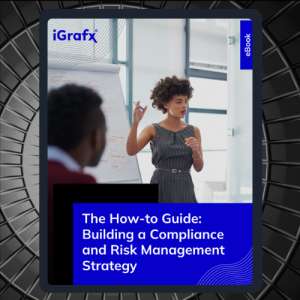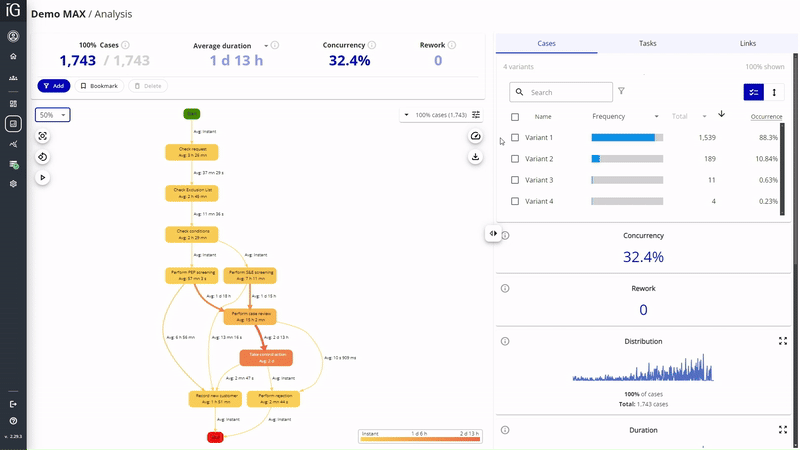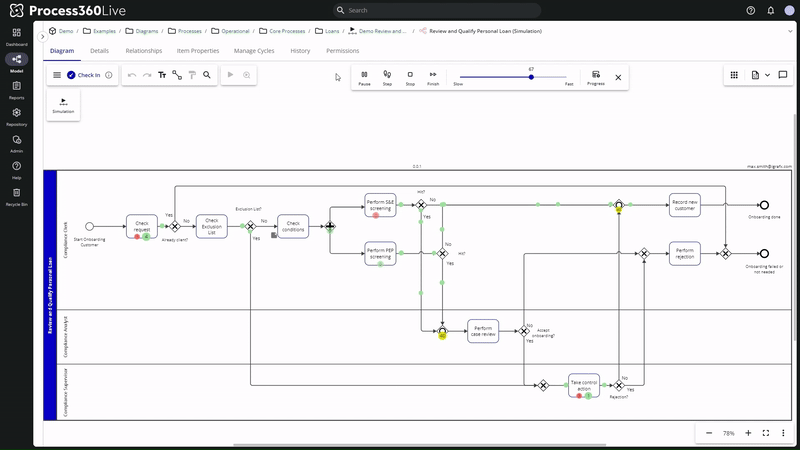Take control of your risk & compliance management
Ensure compliance with regulations and internal policies to avoid penalties and reputational damage.
Managing Risk & Ensuring Compliance
Benefits
01

Resilient Operations
Measure the scope and impact that process changes required for new regulation will have. Come to business conversations prepared with data and strategies to implement effective change.
02

Clear Communication
Foster collaboration through a single source of truth that captures the perspectives of the 3 lines of defense (business units, Risk & Compliance teams, and internal audit).
03

Lightning-Fast Audits
Audits become fast, simple, and inexpensive. Conformance checking between actual operations and approved process models automatically proves compliance and highlights failed controls.
The How-to Guide: Building a Compliance and Risk Management Strategy
Compliance is an expensive, time-consuming and increasingly complex beast, but with potentially colossal financial consequences for non-compliance, it is a necessity.
That means businesses require a robust compliance and risk management strategy in order to avoid fines, uphold their reputation and respond to audits – both internal and external.

Discover
Discover how your business processes run today to uncover potential business risks and compliance issues.
Risk and compliance professionals need comprehensive visibility into as-is business processes. iGrafx offers a suite of capabilities that enable this, including process mining, task mining, and process mapping.
Design
Collaboratively design the ideal future versions of your processes and ensure compliance with regulations and internal policies.
iGrafx’s process design solutions, such as our BPM and process simulation capabilities, enable compliance professionals to thoroughly model and test risks and controls, regulatory scenarios, and risk mitigation measures.
Optimize
Optimize your processes for maximum performance and effective risk management aligned with corporate strategy.
Ensure that process changes don’t inadvertently disrupt internal controls and notify compliance teams as new risks arise with iGrafx’s predictive analytics and process monitoring capabilities.
The iGrafx Approach
Capability Highlights
The all-in-one process intelligence platform purpose-built to drive operational excellence and compliance.
Process Mining
Proactively mitigate risks, ensure process conformance, and stay audit-ready with 100% objective visibility into how your as-is processes are running.


Process Design
Digitally model your enterprise through objects, and their relationships, including digital representations of regulatory structures and risk and control catalogs.
Process Simulation
Mitigate compliance and operational risk by using process simulation to forecast the downstream effects of change.

Resources
Featured blog
01
Regulatory compliance has become the silent profit killer across North American businesses. Organizations in heavily regulated industries, e.g., healthcare, finance, and insurance, face substantial financial and reputational risks that have only intensified with new regulations rolling out quarterly. In fact, in the past decade, regulatory
You have questions, we have answers
What are the main problems facing risk and compliance professionals in the current climate?
Risk and compliance professionals face a volatile landscape, with key problems including the increasing complexity and volume of global regulations, particularly around AI, data privacy, and ESG. They struggle with fragmented data, siloed functions, and a lack of end-to-end process visibility, hindering effective risk identification and mitigation. Additionally, the rapid evolution of cyber threats and third-party risks demands constant vigilance and agile adaptation with often stagnant budgets.
What are some potential threats to compliance?
Five potential threats to compliance include:
- Evolving regulations: Rapidly changing and increasing complexity of laws.
- Data silos/quality: Fragmented, inconsistent, or inaccurate data preventing comprehensive visibility of risk.
- Technological gaps: Insufficient or outdated systems for monitoring and reporting.
- Lack of training/culture of compliance: Insufficient employee understanding or a weak ethical environment.
- Third-party risks: Compliance failures by vendors or business partners.
What is the primary cause of compliance failures?
Compliance failures in business often stem from a lack of a robust compliance culture and insufficient leadership commitment. When compliance is viewed as a mere tick-box exercise, rather than an integral part of business operations, it leads to:
- Inadequate resources: Underinvestment in personnel, technology, and training.
- Poor training/awareness: Employees not understanding rules or their role in compliance.
- Fragmented processes: Siloed data and lack of end-to-end visibility.
- Misaligned incentives: Business goals overriding compliance due to pressure.
- Weak accountability: No clear ownership or enforcement of compliance standards.
What is a risk and compliance framework?
A risk and compliance framework is a structured system that outlines how an organization identifies, assesses, mitigates, and monitors risks while ensuring adherence to relevant laws, regulations, and internal policies. It provides a holistic approach to managing uncertainty and legal obligations, integrating governance, risk management, and compliance activities to protect the business and achieve its objectives ethically.
What are the 5 stages of risk management?
The 5 stages of risk management are:
- Risk identification: Pinpointing potential risks that could affect objectives.
- Risk analysis: Evaluating the likelihood and impact of identified risks.
- Risk evaluation: Comparing analyzed risks against pre-defined risk criteria to determine significance.
- Risk treatment or mitigation: Developing and implementing strategies to modify risks (e.g., avoid, reduce, share, accept).
- Risk monitoring and review: Continuously tracking risks, reviewing the effectiveness of treatment plans, and identifying new risks.
Talk to a process intelligence expert
If compliance and risk management are at the top of your priority list, find out how iGrafx can help.



